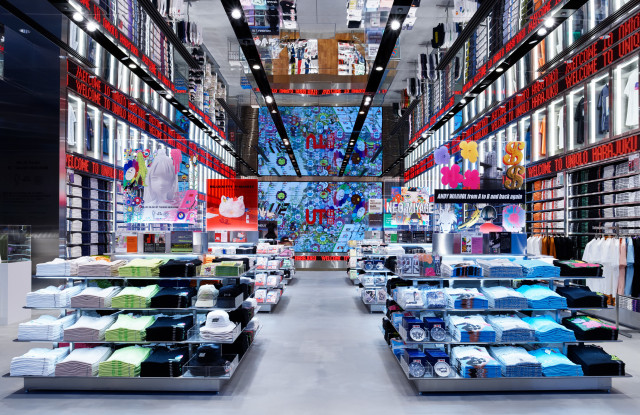The complex was scheduled to open in April, but the date was pushed back due to COVID-19.
TOKYO — After its original April planned opening date was pushed back due to the coronavirus pandemic, a new mixed-use complex will open its doors Friday, directly across from the Japanese capital’s busy Harajuku station.
Anchored by Japan’s first city-center Ikea store and one of the largest Uniqlo stores in the world, the complex is also home to luxury residences. Other tenants include Shiseido Parlour, Oshman’s, Dr. Martens, local outdoor lifestyle brand Snow Peak, Seiko, and a multibrand cosmetics store, hair and makeup salon called Beauty Square.
The Uniqlo store represents something of a homecoming for the brand, as Harajuku was home to its very first urban location some 22 years ago. After closing its UT store in the neighborhood eight years ago, Uniqlo was absent from the area until now. Its new digs have a sales floor area of over 21,300 square feet and a separate section where customers can shop via its own StyleHint smartphone app.
“This store is the continuation of something that began with Uniqlo Park in Yokohama,” said Uniqlo’s chief executive officer in Japan Maki Akaida, referencing another store that opened recently outside of Tokyo. “It is a place for the birth of new culture, and a store that embodies the LifeWear concept.”
When customers enter Uniqlo Harajuku from the street level, they find themselves in the UT section of the store. In addition to displays showcasing some of the many T-shirt collaborations the brand undertakes, the current display includes a 10-foot-tall sculpture of Billie Eilish by artist Takashi Murakami, created specifically for the store to commemorate the designs the two made for UT. The store also sells some of the first lifestyle merchandise under the UT brand, including ceramic dishes, notebooks and other stationery items.
A central staircase under a large screen at the back of the store leads to the lower level, which houses a large collection of Uniqlo’s LifeWear collection for men and women. The styling of the mannequins reflects the youthful vibe and clientele that frequent the area.

Uniqlo StyleHint courtesy
Some unique aspects of this particular Uniqlo store include displays of books — some of which are for sale — that reference Tokyo and Harajuku’s unique history and culture, a listening corner in collaboration with Spotify and young, local musicians and bands, a flower stand, and a sustainability corner with clothing recycle bins and displays illustrating Uniqlo’s environmental efforts. At the moment the display explains how plastic drink bottles are recycled to become the fiber used in the brand’s Airism line of inner wear.
But perhaps the most interesting section of the store is StyleHint Harajuku, located a few steps from the main store on the lower level. The back wall is lined with 240 touchscreen displays where customers can use Uniqlo’s StyleHint app to create outfits, get style inspiration, view the store’s stock in real time, find items on the store’s floor plan, and more.
To help prevent the spread of COVID-19, staff at the store will be wearing masks, and will monitor the number of customers, limiting how many can enter the store at once if necessary. Upon entering the StyleHint store, customers will be asked to sanitize their hands and to use a pre-sanitized stylus rather than their fingers on the touchscreens. When finished, the used styluses are returned to a separate container to be re-sanitized before being used by subsequent shoppers.

Shiseido Parlour The Harajuku. courtesy
On the eighth floor of the With Harajuku building is Shiseido Parlour The Harajuku, a restaurant and lounge with sweeping views of the lush forest that surrounds Meiji Shrine, just behind Harajuku station. Makoto Suzuki, president of Shiseido Parlour, said that the restaurant’s location means that it will naturally cater to a slightly different demographic than is representative of its customers in other locations, such as Ginza.
“At our Ginza location we get a lot of customers in their forties and fifties who are out shopping with their families,” Suzuki said. “But their children want to go shopping in Harajuku, so this gives them a place to have a meal when they do that. We also expect to have many customers who are visiting Meiji Shrine.”
The design of the restaurant incorporates rich textures and deep shades of blue and green to complement the trees outside the floor-to-ceiling windows. Starting from Friday, it will be open for lunch only, with its official grand opening planned for June 16. In accordance with virus-spread prevention measures outlined by the Tokyo metropolitan government, it will operate at only a third of its capacity for the time being, and all staff will wear face masks.

